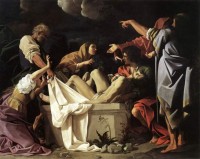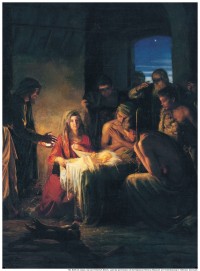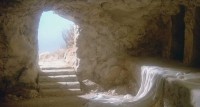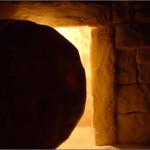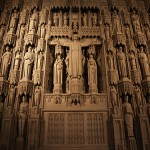I apologize in advance for the graphic nature of this post about the crucifixion of Jesus.
We all know Jesus was crucified. But since nobody is crucified today, few of us realize how painful and gruesome crucifixion was. Two thousand years of separation has sanitized it. For example, if you do an image search on Google for crucifixion, most of the images of Jesus are pretty clean. It looks like he stepped out of a shower, climbed up on the cross, and had some nails driven through his hands and feet…which hardly bled at all.
If there is one thing we can thank Mel Gibson for, it is showing us the graphic and torturous nature of the crucifixion in his movie, The Passion of the Christ. Here is an image from the movie which is somewhat closer to how Jesus probably appeared:
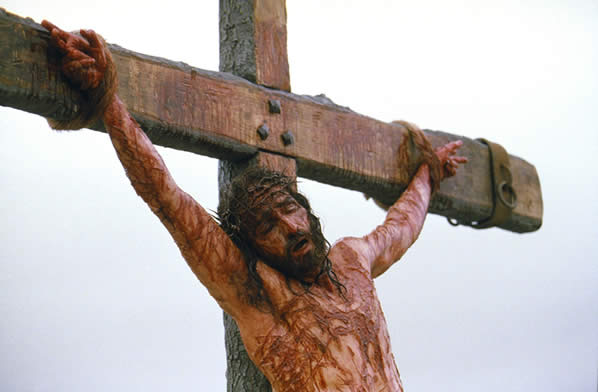
While I have no desire to be provocative in explaining the details of the crucifixion of Jesus, I do think it is important for us to understand the physical suffering of Jesus as it shows us how much we are loved and what he went through for us.
2015 Edit: My thinking has changed quite a bit since I wrote this article over ten years ago. Today, I am not so sure that Jesus wants us to know how much pain and suffering He experienced on the cross. To learn more about how my thinking has changed, sign up at the bottom of this page to receive my emails about the death and resurrection of Jesus. Through that sequence of emails, I show how my thinking has changed about the death and resurrection of Jesus.
History of Crucifixion
The first known practice of crucifixion was by the Persians, and it was closer to impaling a person on a sharpened pole than what we think of as crucifixion. In the book of Esther, Haman builds a “gallows” 75 feet tall upon which he wanted to hang Mordecai (Esther 5:14). This was not a hangman’s gallows like we see in Western movies with the looped noose, but was a large pole stuck into the ground, with the top sharpened to a point. A person was impaled on this stake, and hung there until they died. The Persians became quite skilled at knowing how to impale a person so they stayed alive for several days.
The Greeks brought crucifixion back to the Mediterranean world during the reign of Alexander the Great. The Romans learned crucifixion from the Carthaginians, and rapidly developed a very high degree of efficiency and skill in carrying it out. This type of torture was normally reserved for traitors, criminals, and murderers.
The Crucifix
There were several different types of crosses that were used over the years. The first type, as I indicated, was simply a sharpened stake in the ground. Later, as rulers sought to prolong the life of the person, they developed the T-type structure we are more familiar with in movies and pictures today.
It was made of two pieces. The upright portion of the cross was called the stipes. The blood of the victim ran down this vertical piece of wood, forming stripes on the surface. Remember that in Isaiah 53, it says that by his stripes we are healed.
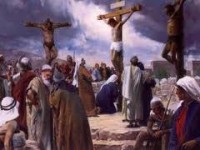 The arm of the cross, or the horizontal part was then attached to the upright piece. Most often, we think of the cross as the one we so often see in pictures, with the horizontal piece about one-fourth to one-third of the way down the vertical piece. But historians and archeologists tells us that probably, the shape of the cross that Christ died on was more like a capital T than a lower case t. This piece was known as the patibulum, and it is this form of the cross that was most often used in Christ’s day. There was also an X-shaped cross, but this was rarely used in the days of Jesus.
The arm of the cross, or the horizontal part was then attached to the upright piece. Most often, we think of the cross as the one we so often see in pictures, with the horizontal piece about one-fourth to one-third of the way down the vertical piece. But historians and archeologists tells us that probably, the shape of the cross that Christ died on was more like a capital T than a lower case t. This piece was known as the patibulum, and it is this form of the cross that was most often used in Christ’s day. There was also an X-shaped cross, but this was rarely used in the days of Jesus.
Sometimes, in the crucifixion of notorious criminals, a small sign was added to the top of the crucifix, stating the victim’s crime. This was called the titulus. The picture on the right shows the criminal on the T-shaped cross, and cross of Jesus with a titulus. According to John 19:19, the titulus of Jesus read, “Jesus of Nazareth, the King of the Jews.”
The upright post (stipes) was permanently fixed in the ground at the site of execution and the condemned man was forced to carry the patibulum from the prison to the place of execution. When John 19:17 says that Jesus carried his cross, it was not the entire cross, but just the patibulum. The entire cross would generally have been too heavy for one man to lift. Even the patibulum proved too much for some men, as it generally weighed about 110 punds, and after the beating which many of them received, could not carry that weight too far.
Crucifixion Methods
There were a couple different ways of “attaching” the victim to the cross, and it all depended on how long the authorities wanted the victim to live. Sometimes, the victim was simply tied to the cross, and they died from starvation. If they were offered water to drink, they could live for weeks before dying.
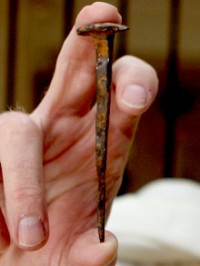 If the authorities wanted a quicker death, they would generally drive nails into the hands and feet of the victim. The nails were not driven into the palms of the hands as most pictures show. Rather, they were driven through the wrist near the hands. If the spikes were driven through the hands, the weight of the person would cause the nail to rip through the hands and the victim would fall off the cross. But when driven through the wrist, the set of bones which attach the wrist to the hand keep the hands from ripping free.
If the authorities wanted a quicker death, they would generally drive nails into the hands and feet of the victim. The nails were not driven into the palms of the hands as most pictures show. Rather, they were driven through the wrist near the hands. If the spikes were driven through the hands, the weight of the person would cause the nail to rip through the hands and the victim would fall off the cross. But when driven through the wrist, the set of bones which attach the wrist to the hand keep the hands from ripping free.
Even then, the crucified victim rarely died from blood loss. Most often, they died from asphyxiation, that is, the inability to breathe. Before the nail was driven through the victim’s feet, the legs were bent at the knee so that the bottom of one foot was flat against the vertical beam. One foot was placed on top of the other, and one long nail was driven through both feet. When the cross was erected, the weight of the body caused the victim to slump, putting all the weight of the body on the nails through the wrists. This also caused compression on the lungs, which kept the victim from inhaling. As long as he was slumped down, he could not take in breath.
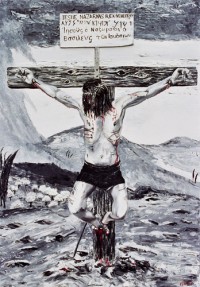 To take a breath, the victim would have to stand up on the nail through his feet, causing excruciating pain in the feet, but enabling him to take a breath. As long as he was putting all his weight on his feet, he could breathe. But when that became too painful, he would slump back down, putting all his weight on his wrists, and also returning to the condition of not being able to breathe.
To take a breath, the victim would have to stand up on the nail through his feet, causing excruciating pain in the feet, but enabling him to take a breath. As long as he was putting all his weight on his feet, he could breathe. But when that became too painful, he would slump back down, putting all his weight on his wrists, and also returning to the condition of not being able to breathe.
Eventually, the victim would become so weak, they could no longer lift themselves up on their feet to take a breath, and they would die from asphyxiation. Some of the stronger victims could last for up to a few days in this state. To speed up a victim’s death, the authorities might command that his legs be broken so that he could no longer raise himself to take a breath. Once the legs were broken, the victim would die within a few minutes.
Let us turn now to look at the specific details of the trial and crucifixion of Jesus.
The Trial of Jesus
 Note: Much of the following information comes from Martin Hengel’s work on Crucifixion, and from an article written by Dr. Truman Davis called “A Physician Testifies About the Crucifixion.”
Note: Much of the following information comes from Martin Hengel’s work on Crucifixion, and from an article written by Dr. Truman Davis called “A Physician Testifies About the Crucifixion.”
After the arrest in the middle of the night, Jesus is brought before the Sanhedrin and Caiaphas, the High Priest. It is here the first physical trauma is inflicted. A soldier strikes Jesus across the face for remaining silent when questioned by Caiaphas. The palace guards then blind Him with a cloth, and taunt Him to identify them as they pass by. They also spit on Him, strike Him in the face, and pull out His beard. Spitting on someone was the lowest form of disgrace to a person in that time. Furthermore, while we do not know exactly how many guards participated, we know from history that the palace guard consisted of 900-1200 soldiers. Even if only ten percent participated, Jesus endured a lot of shame, disgrace, and pain at the hands of the soldiers.
In the early morning, Jesus, battered and bruised, dehydrated, and exhausted from a sleepless night is taken across Jerusalem to the Praetorium of the fortress Antonio, the seat of government of the procurator of Judea, Pontius Pilate. Pilate tries to pass the responsibility to Herod, the tetrarch of Judea. Jesus apparently suffered no harm at the hands of Herod and is returned to Pilate. It was then in response to the cries of the mob, that Pilate orders Barabbas released, and condemns Jesus to scourging and crucifixion.
The Scourging of Jesus
Preparations for the scourging are carried out. Jesus is stripped of His clothing, and His hands are tied to a post above His head so that the flesh of the shoulders and the back are stretched to the limit. The Jews had an ancient law prohibiting more than 40 lashes which is why Paul several times received 39 lashes. But the Romans made no attempt to follow Jewish law in this matter and Jesus probably received many more.
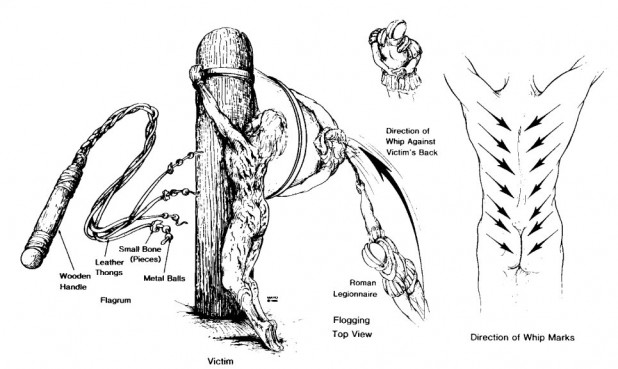
When the back of Jesus is bared and stretched tight, a Roman legionnaire steps forward with the flagrum (sometimes it is called a flagellum or cat-of-nine-tails) in his hand. It is a short whip consisting of nine heavy leather thongs, each with small lead balls, embedded with bits of glass, stone, or bone attached near the ends. The heavy whip is brought down with full force again and again on the shoulders, back, and legs of Jesus.
At first the heavy thongs cut through the skin only. Then, as the blows continue, they cut deeper into the subcutaneous tissue, producing first an oozing of blood from the capillaries and veins of the skin, and finally spurting arterial bleeding from vessels in the underlying muscles. The small balls of lead, bits of glass, and stone produce large, deep bruises which are broken open by subsequent blows. Eventually, the skin on the back hangs in long ribbons, and the entire area is an unrecognizable mass of torn bleeding tissue.
The blows do not hit just the back either. When the long strands of the flagellum strike, they wrap around the victim’s body and dig into the front and sides of the body. Then the flagellum is quickly pulled back, violently ripping and tearing the flesh off the body. Sometimes, in the process, a victim will have several ribs broken by the lead balls. This probably did not happen with Jesus since it was prophesied that none of His bones would be broken. When it is determined by the centurion in charge that the prisoner is near death, the beating is finally stopped.
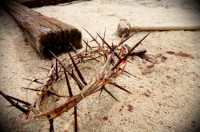 The half-fainting Jesus is then untied and allowed to slump to the stone pavement, soaked with His own blood. The Roman soldiers see an opportunity to make a joke out of Him. Here is a provincial Jew claiming to be a king, but was now barely alive. So they throw a robe across His shoulders and place a stick in His hand for a scepter. To make the travesty complete, a small bundle of flexible branches covered with long thorns are woven into the shape of a crown and pressed into His scalp. Since head wounds always bleed a lot, the blood runs down His face and into His eyes.
The half-fainting Jesus is then untied and allowed to slump to the stone pavement, soaked with His own blood. The Roman soldiers see an opportunity to make a joke out of Him. Here is a provincial Jew claiming to be a king, but was now barely alive. So they throw a robe across His shoulders and place a stick in His hand for a scepter. To make the travesty complete, a small bundle of flexible branches covered with long thorns are woven into the shape of a crown and pressed into His scalp. Since head wounds always bleed a lot, the blood runs down His face and into His eyes.
After mocking Him and striking Him across the face some more, the soldiers take the “scepter” from His hand and strike Him on the head, which drives the thorns deeper into His scalp. After they tire of their sadistic sport, the robe is torn from His back. It had already adhered to the clots of blood and ribbons of flesh on His back, and had begun to dry in the hot mid-eastern sun. The tearing of the robe from His back, just like the careless removal of a surgical bandage from a wound, causes excruciating pain as wounds reopen and more flesh is torn from His back.
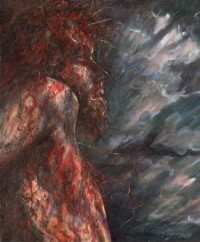 Most artists do not even come close in depicting what Jesus looked like after all of this torture. He was probably the most inhuman looking thing you’ve ever seen. The prophet Isaiah wrote of the Messiah: “They shall see the Servant of God beaten and bloodied, an object of horror; so disfigured many were astonished. His face and His whole appearance were marred more than any man’s, one would scarcely know it was a person…” (Isa 52:14).
Most artists do not even come close in depicting what Jesus looked like after all of this torture. He was probably the most inhuman looking thing you’ve ever seen. The prophet Isaiah wrote of the Messiah: “They shall see the Servant of God beaten and bloodied, an object of horror; so disfigured many were astonished. His face and His whole appearance were marred more than any man’s, one would scarcely know it was a person…” (Isa 52:14).
The Journey to Golgotha
The soldiers then take the heavy patibulum, and tie it roughly to Jesus’ shoulders. The procession leads down the Via Dolerosa. With Jesus are the two thieves who will be crucified with Him, and the execution detail of Roman soldiers. They walk slowly through the crowded streets. Some people jeer and mock. Others shrink back in horror.
In spite of His efforts to walk erect, the weight of the heavy wooden beam, together with the shock produced by blood loss, is too much for Jesus. He frequently stumbles and falls. When He does so, the rough wood of the beam gouges into the lacerated skin and muscles of His shoulders and sends splinters deep into His skin. At one point, He tries to rise, but human muscles had been pushed beyond their endurance. The centurion, anxious to get on with the crucifixion, selected a stalwart North African onlooker, Simon of Cyrene, to carry the crossbeam. Jesus follows behind, still bleeding, and sweating the cold, clammy sweat of shock.
After the 650-yard journey from the fortress Antonio to Golgotha is complete, the crucifixion begins.

The Crucifixion
Prior to nailing Jesus to the cross, He is offered wine mixed with myrrh (Mark 15:23). This was a mild anesthesia, and was intended to help numb the pain. Jesus refuses this drink. Simon is ordered to place the patibulum on the ground, and Jesus is roughly thrown backward upon it with His shoulders against the wood. The legionnaire feels for the depression at the front of the wrist, places a spike in the depression, and quickly drives a heavy, square, wrought iron nail through the wrist and deep into the wood. He moves to the other side and repeats the action, making sure he does not pull the arms too tightly. The patibulum is then hoisted to the top of the stipes, and the titulus is nailed into place.
The left foot is now pressed backward against the right foot, and with both feet extended, toes down, a nail is driven through the arch of each, leaving the knees moderately flexed. Death by crucifixion now begins.
As Jesus slowly sags down with the weight of His body on the nails through His wrists, excruciating, fiery pain shoots along the most sensitive nerve endings in the body – called the median nerves – and travels along the fingers and up the arms to explode in the brain.
At this point, another phenomenon occurs. As the arms fatigue, great waves of cramps sweep over the muscles, knotting them in deep, relentless, throbbing pain. With these cramps come the inability to push Himself upward. Hanging by His arms, the pectoral muscles are paralyzed, and the intercostal muscles are unable to act. He can draw air into the lungs, but it cannot be exhaled.
Jesus fights to raise Himself in order to get even one short breath. Finally, carbon dioxide builds up in the lungs and blood stream and the cramps partially subside. Spasmodically, He is able to push Himself to exhale and bring in more life-giving oxygen. Doing so, however, comes at a price. To get a breath and relieve the pain in His arms and chest, He pushes Himself upward, placing His full weight on the nail through His feet. The searing agony transfers from His wrists to His feet, tearing through the nerves between the metatarsal bones of the feet. Nevertheless, He gets a breath, and sags back down. It is undoubtedly during these periods of breathing that He uttered His seven short sentences which are recorded in the Gospels.
When air is so precious, and each breath so painfully won, He still uses that breath to communicate with people who are near. The first sentence, looking down at the Roman soldiers throwing dice for His seamless garment, is “Father, forgive them for they know not what they do.” In my mind, this is one of the most remarkable statements in all of Scripture.
The second statement, to the penitent thief, is “Today, you will be with me in Paradise.”
The third, looking down at the terrified, grief-stricken John (the beloved apostle), He says, “Behold, your mother,” and looking at Mary, “Woman, behold your son.” He was telling them to take care of each other.
The fourth cry is from the beginning of Psalm 22, and shows that not only was Jesus experiencing great physical torment, but was also undergoing intense spiritual pain. He says, “My God, My God, why have you forsaken me?”
Hours of this limitless pain, cycles of twisting cramps, and intermittent partial asphyxiation, eventually lead to another type of pain. He begins to experience a deep, crushing pain in the chest as the pericardium slowly fills with serum, and begins to compress the heart. This did not happen to all victims of crucifixion, but was known to occur. In the case of Jesus, it sped up His death. The loss of tissue fluids has reached a critical level, the compressed heart is struggling to pump thick, heavy blood into the tissues, and the tortured lungs make a frantic effort to gasp in small gulps of air. The markedly dehydrated tissues send their flood of stimuli to the brain.
Jesus gasps His fifth cry, “I thirst.” In response, a sponge soaked in Poska, the cheap, sour wine which is the staple drink of the Roman legionnaires, is lifted to His lips. Since this was different from the drugged wine He had been offered earlier (Mark 15:23), He did drink some of this (John 19:29-30). The body is now in extremis, and He can feel the chill of death creeping through His tissues. This realization brings out His sixth saying, possibly little more than a tortured whisper, “It is finished.”
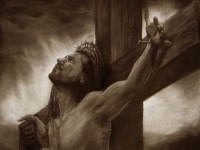 His mission of atonement is nearly complete. Finally, He can allow His body to die. With one last surge of strength, He presses His torn feet against the nail, straightens His legs, looks into heaven, and utters His seventh and last cry, “Father, into your hands I commit my spirit.”
His mission of atonement is nearly complete. Finally, He can allow His body to die. With one last surge of strength, He presses His torn feet against the nail, straightens His legs, looks into heaven, and utters His seventh and last cry, “Father, into your hands I commit my spirit.”
While it generally took about two or three days for a crucified victim to die on the cross, due to the loss of blood and the compression upon His heart due to lungs filled with fluid, Jesus died in about six hours. Since the crucifixion took place on the eve of a Sabbath (probably not a Saturday Sabbath, but a Passover holiday Sabbath), and because it was against Jewish law for a crucified person to hang on the cross during a Sabbath, the Roman soldiers come around to break the legs of those being crucified.
When this was done, the victim was then unable to lift themselves up in order to breathe. They would be able to draw in air, but not be able to exhale it. When the legs were broken, it was only a matter of a few minutes before the victim would die of suffocation.
So the legs of the two thieves were broken, but when they came to Jesus, He is already dead. The legionnaire drives a spear into Jesus’ heart to see if He was dead. Scripture reports that “immediately there came out blood and water.” Jesus’ legs did not have to be broken, which fulfilled the Scripture that said that none of the Messiah’s bones would be broken.
Jesus is taken down from the cross, wrapped in burial clothes, and laid in a stone tomb.
Why is it important to know this?
Why am I sharing this? Because we need to know what Christ went through for us. He went through all of this because He loves us. My purpose is not to make you feel guilty, but for you to see how great the love of Jesus is. But let not your heart be troubled… for the resurrection is coming!
To understand the REAL significance of the crucifixion, get my new book, The Atonement of God.
The cross of Jesus is CENTRAL to everything!
Transform your life and theology by focusing on the crucifixion and resurrection of Jesus:
Fill out the form below to receive several emails from me about the death and resurrection of Jesus.
(Note: If you are a member of RedeemingGod.com, login and then revisit this page to update your membership.)


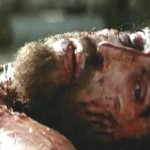
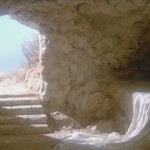
 The differences between Christmas and Easter could be told as The Tale of Two Fridays.
The differences between Christmas and Easter could be told as The Tale of Two Fridays.